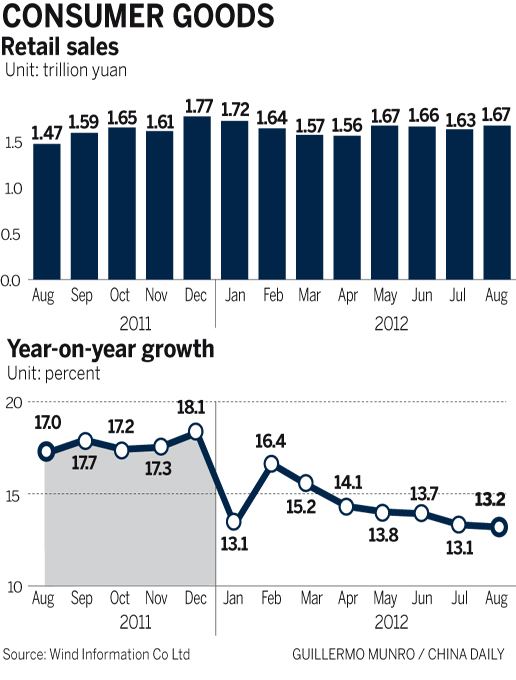|
 |
|
An advertisement for Apple Inc's new iPad in Beijing.?[Photo/China Daily] |
Sector shows strong growth potential amid rising domestic consumption
Li Na, a young teacher in Changsha, Hunan province, finally got her iPad 2 recently after making a down payment of 1,800 yuan ($283) and paying monthly installments of 416 yuan over the next year.
"I dreamed about it for a long time and now I can use it. It would take me another half a year if I put aside money from my monthly salary of 2,000 yuan to pay for it," Li said.
The teacher, who doesn't have a credit card, found about the loan - which came with a fee of 25.7 percent of the price the iPad - from a saleswoman at a electronics store.
Li is one of the 1.75 million clients of Home Credit, a Czech financial company that has tapped China's consumer finance market. Analysts say that the market is set to boom in the coming years supported by increasing personal incomes and the government's efforts to expand domestic consumption.

Consumer finance refers to short-term loans for personal purchases of durable goods or services such as home decoration, healthcare and education.
Consumer finance companies are non-banking financial institution providing Chinese residents with loans for consumption purposes. According to China Banking Regulatory Commission rules, these companies are unable to take part in deposit taking business, or provide mortgages or auto loans.
China's consumer finance sector is less developed than in developed economies, but it will be one of the most promising industries in the nation in the near future, said Yan Xuan, president of Nielsen Greater China.
The current penetration of consumer finance in the mainland is quite low, accounting for only about 4 percent of the total consumer lending balance, compared with up to 10 percent in more developed markets such as Hong Kong, according to a report by Boston Consulting Group in August 2011.
"China is now shifting the driving force of its GDP growth from investment to domestic consumption, which will create more room for consumer finance. The consumer finance industry will experience relatively fast development in the next decade," said Sun Tianqi, assistant to the head of the research bureau of the People's Bank of China.
Consumer finance serves as a key component of the government's plan to stimulate overall domestic consumption.
In 2009, the CBRC launched a pilot program approving four consumer finance companies: Bank of Beijing Consumer Finance Co in Beijing, BOC Consumer Finance Co in Shanghai, Jincheng Consumer Finance in Chengdu, and Home Credit in Tianjin.
China's size and its rapidly growing middle class make it an obvious target market for foreign banks. Between them, the country's 1.3 billion citizens hold nearly $2 trillion in personal savings, according to a report by KPMG.
The 21st Century Business Herald cited an unnamed source close to the CBRC as saying that the government will approve a new batch of licenses of consumer finance companies outside of the four pilot cities and the first companies among the new batch are expected to be granted licenses in September.
Policies regarding the regulation of consumer finance business are expected to be adjusted following the announcement of new consumer finance licenses in the second half of this year, according to the newspaper.
The current regulations issued by the CBRC in 2009 have rigid requirements for consumer finance lenders, including a capital adequacy ratio no less than 10 percent, a reserve adequacy ratio of no less than 100 percent and interbank borrowing no higher than 100 percent of the total capital.
But the requirement for establishing small-loan companies is less stringent - they must have several tens of millions of yuan in registered capital and have more diversified business types, including general consumer loans, car loans and mortgages.
In early August, the Guangdong provincial government allowed Hong Kong financial institutions to set up consumer finance companies in the province.
The policy attracted more players into the consumer finance domestic market and intensified competition in the sector. Some small-loan companies even indirectly engaged in the business following the principle of entering the market first and getting their license later.
Japanese retail giant AEON Group set up a small-loan company in Shenyang, Liaoning province, in September 2011 with registered capital of 44 million yuan, providing an installment loan service for durable consumer goods including home appliances and furniture. The group also operates debt collection and call center services in Beijing and Shenzhen.
A brochure from the group shows that the lender provides loans of between 500 yuan and 100,000 yuan, and approval for each loan takes about 30 minutes with no need for a credit card or collateral. The borrower is required to pay interest at a rate of 1.2 percent per month and a one-time application fee totaling 1 percent of the loan amount.
The group has extensive business coverage in China, including in shopping malls, which could give its consumer finance business the upper hand.
Credit Saison plans to start installment business in Vietnam and China in 2013 for motorcycles and home appliances. Orient Corp plans to start an installment business for automobiles in China in three years.
"Bank-backed consumer finance companies have more advantages than small-loan companies in consumer finance. The investment required to start consumer finance business is great while banks have plentiful capital, professional knowledge and a wide network. In addition, many banks are now emphasizing the consumer finance business," said Zhao Qingming, a professor at the University of Business and Economics in Beijing.
The Consumer Finance Center (Shanghai) of Bank of Nanjing was opened in June and two consumer finance products were launched jointly with Bank of Paris. Bank of East Asia and Wing Hang Bank from Hong Kong have also expressed a strong interest in this business.
Pavel Vyhnalek, group chief executive officer of Home Credit, said that "the major threshold for consumer finance business is technology and capital, and thus not all financial companies have the ability to get into the business".
Home Credit's total investment, including registered capital, building up sales outlets and technology services, reached around 250 million euros ($319.5 million) after it entered China in 2007. The company has yet to recover these costs, though it has issued 4.2 billion yuan in loans and the number of its clients reached 1.75 million by June 2011.
Consumer finance companies' customers are mainly from the low- and middle-income brackets. They usually don't have any credit record and the loans provided to them are small and unsecured. Therefore, the key to profit, and core competitiveness, is an effective risk control mechanism and operational process.
GE's consumer finance company entered China earlier than Home Credit but failed to expand its business.
"We set up an effective risk management mechanism for emerging markets and it brings us better assets, a higher market share and more profits," said Jakub Kudrna, chief risk officer of Home Credit Europe.
However, the low ratio of non-performing loans of the four domestic players suggests that the lenders have a rather conservative attitude toward the sector, and indicate the great scope for them to profit from the domestic consumer finance market.
"China's consumer finance market is like that in Russia 10 years ago and I believe it will grow fast in the coming years," said Vyhnalek.
"The biggest obstacle now is regional restrictions. As long as we can do business nationwide, or if Home Credit can cooperate with big retailers such as Suning and Gome on a nationwide level, consumer finance can grow to more than 30 percent of retailers' sales volume."
Home Credit started its consumer finance business in Russia in 2002 and provides loan services for one-third of the country's households.
"Consumer finance can also help China to expand domestic consumption as the country seeks to rebalance its economic growth. Consumer finance's target customers are mass consumers that have medium or low but stable incomes. Even though they are not the focus of traditional credit providers, they account for a big portion of the population," said Vyhnalek.
According to Home Credit's statistics, until March this year, 74 percent of the Chinese population have a monthly income between 1,000 and 3,000 yuan.
"Consumer finance increases the purchasing power of these customers and also helps to build their personal credit record, complementing the part of the financial system which banks don't cover," Vyhnalek said.
lijiabao@chinadaily.com.cn
